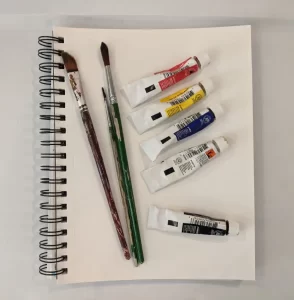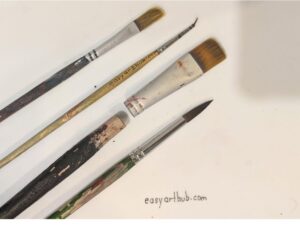If you are to paint unconventional painting surfaces, you might come across some challenges in making acrylic stick and stay. This post aims to help you understand and address those issues.
Gesso priming before and sealing after painting helps acrylic paint adhere permanently to traditional painting surfaces like canvas. For more challenging surfaces, additional steps like sanding, unwaxing, adding other medium, and applying heat could be done to ensure proper adherence.
~This post contains affiliate links.
How to make acrylic paint adhere to almost any surface permanently?
Although some materials will be more challenging, it is still possible to paint them with acrylic. It will take more time and effort as it will need more preparation.
Below are a few tips to make acrylic stick to the surface and avoid any peeling. I added examples of surfaces that will best benefit from each of the tips.
Make the surface rough (for smooth surfaces )
Very smooth surfaces can be roughened by sanding or etching the surface. After the grit has been added, make sure to completely clean the surface. Leftover dust or particles can affect the adherence of the paint or the texture of the finished painting.
Examples of surfaces: smooth glass, plastic, metal
Note: I won’t recommend sanding surfaces that are treated with non-stick coating.
Make the surface smooth (for rough or uneven surfaces)
Rough surfaces can be smoothened and evened out with sandpaper. Make sure to clean well after.
Examples of surfaces: wood, uneven primer
Sealing before priming
A very absorbent surface can be sealed before priming. This also helps avoid future discoloration when using raw organic surfaces.
Examples: wood & fabric
Remove any oil (for oily or waxy surfaces)
Oily/waxy surfaces can be cleaned with soap and water or wiped with alcohol and let completely dry. Soap and alcohol break down the oil/wax particles.
Rocks coated with wax can be soaked in hot soapy water to remove the wax. I discuss this in detail in this post on How to prepare rocks for painting.
Examples of surfaces: store-bought stones
Prime with gesso (for any surface)
Priming the canvas adds grit and balances the absorbency of any painting surface. I discussed it in more detail in my post about Canvas and Other Painting Surfaces.
You can use gesso or make your own by mixing some powder chalk or cornstarch to the acrylic paint.
Examples of surfaces: all types of surfaces
Complete Drying
Always make sure the surface is completely clean and dry before painting and sealing. This will help the paint adhere better and faster.
Examples of surfaces: all types of surfaces
Applying Heat (for clothes or fabric)
Applying heat reduces does not only reduce drying time, but it can also strengthen the particles’ bond.
You can try this trick by gently ironing (no steam) the back of a completely dried painting on clothes. Using a hairdryer might work too, to a lesser degree.
This will may not work depending on the type of fabric, acrylic paint, and thickness of the paint. Test it first to avoid ruining a valuable piece.
Examples of surfaces: canvas bags
Adding fabric medium(for clothes or fabric)
Adding a fabric medium to acrylic paint can prolong the life of painting on clothes and garments.
Examples of surfaces: canvas bags, clothes
Sealing after painting
When the painting is completed, it is usually finished with sealant or varnish. This protects the artwork from dust or other elements. Sealing also helps keep the paint firmly attached to the surface, especially the smooth ones.
Examples of surfaces: most surfaces except those that don’t hold shape like fabric
What makes acrylic paint stick?
To understand what makes acrylic paint stick to the surface, we have two sides to consider, the paint and the surface.
Caution: the following will be a bit nerdy but useful knowledge for those who want to optimize the use of acrylics.
Acrylic paint composition
The 2 basic components of acrylic paint are pigment and acrylic polymer emulsion. One of them is what makes the paint stick.
1. Pigment
It is the powdery substance that gives the color of the paint.
2. Acrylic Polymer Emulsion.
This emulsion is a combination of water and acrylic polymer.
Water serves as a vehicle for the pigment, making application and absorption into the painting surface possible. It also prevents the particles of the binder from binding pigment and surface together, temporarily.
Acrylic polymer is the binder used for acrylic paint, hence the name acrylic paint. This binder acts as the glue that keeps the pigment and surface together. Once completely dried, this creates a strong and permanent film of paint.

Note: The above diagram is an oversimplified version of the very complex science of how acrylic paint dries into a film.
Qualities of a good painting surface
Below are the qualities that help a surface accept and keep the paint.
Grit or “tooth”
When the paint is applied in liquid form, some of its particles are able to go into the tiny spaces (a.k.a. “tooth” or grit) within the painting surface. Enough “tooth”, means enough surface area to bind. As the paint dries, the water evaporates allowing the binder to come in contact with the pigment and surface.
The binder then starts binding the pigment particles and surface. This creates a strong film that is firmly and permanently attached to the surface. Without grit, the paint will still dry into a film but will just peel off easily.
Too much grit, or too rough can also be a problem as it will be too hard to have good coverage with a brush.
Absorbency
Absorbency (or porosity) is another factor to consider when choosing the painting surface. Although it is necessary for the canvas to be able to absorb a little bit of the paint, too much of it is not a good thing. Too absorbent and it will be hard to create the desired art as the paint will just seep.
Absence of oil /wax/fat
As discussed, water acts as a temporary barrier for the binder to bind the particles. It is temporary since water evaporates fairly quickly. Oil or wax does not evaporate the same way as water, thus it creates a long-term barrier that prevents the complete binding process. Although the paint may be able to adhere and dry into a film, it will not be as strong and permanent.
Flat
It is much easier to paint on a flat panel or canvas than on an odd-shaped rock or bottle. The latter will be more challenging, but still doable.
Hold its shape
A surface that doesn’t get deformed is best for acrylic painting. It will be challenging to paint on surfaces that don’t hold their shape (such as clothes or unframed fabric). Although the paint can stick, it will eventually break or lift because of folding and washing.
No Non-Stick coating
Materials that are non-stick like Teflon or silicon repel anything, including paint. For folks who might be thinking of painting those unused Teflon pans, it will not work. They might make a nice mixing palette though.
In my post, Canvas and Other Painting Surfaces, I discussed the all thing you need to know about the best painting surface if you are just starting your acrylic painting journey. It also covered other non-conventional surfaces you can possibly paint.
How to know if the paint will adhere to the surface?
If you will be working on a valuable but unconventional painting surface, you may want to test for adherence. It will be a good idea to know that before spending lots of time, effort, and materials on an important project.
A Scratch test is a simple way to find out if the paint will stick permanently to a specific type of surface. It can be done in a small sample of a bigger surface.
Scratch Test (Steps)
- Paint a small portion of the surface. Let it dry.
- Scratch. Using a sharp object, add a cross.
- Tape. Secure a masking tape on top of the scratch.
- Evaluate. Pull the tape quickly and inspect. If some of the paint comes off, then it’s not good to paint. If no paint comes off, that means the paint has good adhesion to the surface.




Note: In picture (#4) above, you will see that lots of paint got removed from the painting surface (glass). This means it will not be a good painting surface unless we address the issue. This and other issues and their solutions will be discussed below.
Conclusion
There are a few tricks one can do to make acrylic paint adhere even to challenging surfaces. Knowing what makes it stick can guide us in addressing common adhesion issues. I hope it will help you explore more painting possibilities.
Happy painting!



